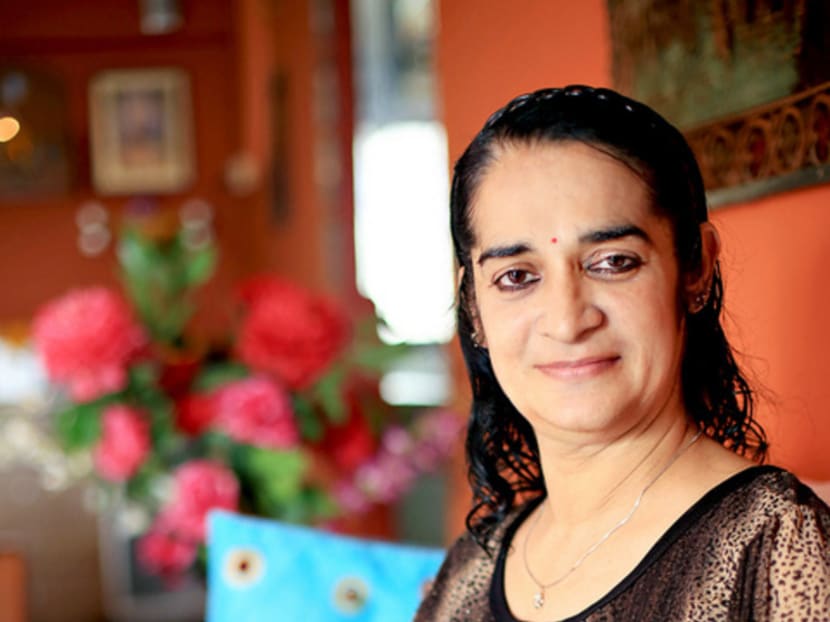Singapore’s first liver transplant patient turns 50
SINGAPORE — Homemaker Surinder Kaur considers it a miracle to be able to celebrate her 50th birthday with the nation’s Golden Jubilee celebrations this year. In 1990, she was the first person to undergo a successful liver transplant in Singapore, after receiving a donor liver from a man who had died in an accident.

Before Mdm Surinder Kaur’s case, patients who needed liver transplants had to go overseas for the procedure. Photo: Koh Mui Fong
SINGAPORE — Homemaker Surinder Kaur considers it a miracle to be able to celebrate her 50th birthday with the nation’s Golden Jubilee celebrations this year. In 1990, she was the first person to undergo a successful liver transplant in Singapore, after receiving a donor liver from a man who had died in an accident.
The liver transplant was performed by a team of doctors from the National University Hospital (NUH). Before Mdm Surinder’s case, patients who needed a liver transplant would have had to travel overseas to do so.
Twenty-five years old then, Mdm Surinder was unaware that she had hepatitis B, which puts a person at a high risk of death from life-threatening conditions such as liver cirrhosis and liver cancer. Mdm Surinder sought medical attention only after the symptoms of advanced liver damage, including jaundice and weight loss, had set in.
Suffering from advanced liver cirrhosis, she was given six months to live without a liver transplant.
WHEN A LIVER TRANSPLANT IS CONSIDERED
Liver transplants are considered when a person’s liver can no longer support life in end-stage liver disease. Donor livers can be obtained from both deceased and living donors.
In Singapore, the most common conditions that require a liver transplant are liver cancer and chronic liver failure from hepatitis B virus infection, said Professor KK Madhavan, co-director of the National University Centre for Organ Transplantation at NUH.
Since 1990, NUH has performed 151 deceased-donor liver transplants and 125 living-donor liver transplants as of July 19 this year. It performed its first living-donor liver transplant in 1996.
A National Liver Transplant Programme is expected to be launched soon this year. Under this programme, all adult liver transplants will be performed in NUH and Singapore General Hospital (SGH) by a single team of surgeons. Previously, liver transplants were performed by the respective teams at NUH and SGH.
In the private sector, living donor liver transplants are done at Gleneagles Hospital and Mount Elizabeth Hospital.
A Ministry of Health (MOH) spokesperson said that elements of the programme, such as a common waiting list and a common national retrieval team for deceased donors, have already been operationalised.
SAVED FROM THE BRINK OF DEATH
Mdm Surinder’s condition deteriorated while waiting for a donor liver. By the time a suitable donor was found five months later, she had become so ill that she was barely conscious. Although the local doctors had never performed such a procedure at the time, Mdm Surinder and her father consented to the transplant surgery.
On Sept 29, 1990, Singapore’s first deceased-donor liver transplant turned out to be a success. Upon regaining consciousness after the operation, Mdm Surinder’s first thought was: “I’m alive!”
Mdm Surinder still tears up whenever she recalls her first sight of her father and brother waving to her from outside the intensive care unit.
“It was an emotional moment. I still cry sometimes thinking about how I’ve managed to survive my illness, and am still surviving 25 years after the transplant. My father said I was given a second chance in life,” she said.
A NORMAL LIFE AFTER A LIVER TRANSPLANT
According to Prof Madhavan, every patient who gets a liver transplant is expected to live a full lifespan.
However, this is not always the case as potentially fatal complications may occur after a transplant, usually from rejection or the long-term use of immunosuppressants.
Said Prof Madhavan, who is heading the National Liver Transplant Programme: “The fact is, at the end of one year, only nine in 10 patients who get a liver transplant are alive.
“At five years, it is close to eight in 10. And at 10 years, it is close to seven in 10. However, the survival rate for these patients would have been close to zero at five and 10 years had they not received a liver transplant.”
Following the transplant, Mdm Surinder went on to live a normal life. She got married and fulfilled her dream of becoming a mother when she gave birth to a healthy baby boy six years later.
Her son is now 19 years old and is currently a biotechnology student at a polytechnic.
Mdm Surinder counts herself extremely fortunate. Most of her medical bills were covered by donors. Her transplant operation and hospital bills, which amounted to approximately S$100,000 for a year, were largely covered by donations from the Sikh community.
The homemaker has to be on immunosuppressive drugs for life to prevent her body from rejecting her transplanted organ.
Mdm Surinder’s husband works as a medic and earns about S$1,200 per month. At S$400 per month, her regular medication bill would have taken a major toll on her family’s expenses if a stranger — a local businessman — had not learnt about her predicament and offered to pay for it.
“My niece has been teasing me for being ‘an SG50’ this year. I am very thankful to be able to survive till now,” she said with a smile.





